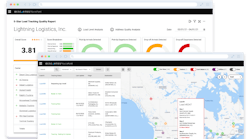Some months, when I sit at my desk and try to think of something, anything to write about in this column, my mind draws a complete blank. Since 2009, my words, for better or for worse, have appeared monthly in Fleet Owner and probably much to the dismay of the editors and readers as well. Still, when it occurs, I push through that complete blank slate of a mind and try to find something absolutely intriguing to write about each month. This is one of those months.
In testimony during a recent hearing on Opportunities and Challenges for Improving Truck Safety on our Highways before a subcommittee for the Senate Committee on Commerce, Science and Transportation, Dave Osiecki, ATA’s chief of national advocacy, extolled the virtues of an industry that preaches safety every day on our nations’ highways.
Many of you are most likely used to hearing words or phrases like that about this industry—and after 15 years of being in trucking, I may have gotten used to writing those words myself. What struck me as new or never before heard words in his testimony was a number that he revealed to be conservative at best, yet very revealing all the same. That number is $7.5 billion, as in the amount of dollars spent annually by an industry dedicated to improving safety and saving lives on our roadways.
To put a little perspective on the $7.5 billion annually spent on safety, if we were to take that same amount and stack it in dollar bill increments, it would rise over 500 mi. into the air. Not feet but miles. If we laid the dollar bills out, we could cover 30 square mi. If you were to spend $20 per second, it would take 4,335 days to spend $7.5 billion.
Since I seemed to have established that this industry’s devotion to safety on our highways comes with an almost unfathomable annual price tag, I wonder why our skeptics never see it that way.
After all, the stats provided in the testimony refer to unprecedented levels of safety achieved; for example, there are 1,018 fewer fatalities in 2012 than in 2002. Consider that in 2012, there were 2.7 million more trucks operating and 54 billion mi. traveled compared to 2002. For any lay person out there who happens to be reading this column, that is what we in the industry refer to as an incredible increase in exposure.
The basic thought is almost always going to be that the more trucks and more miles, the more accidents will happen, but in today’s trucking industry, this is not the case. We devote our efforts to safety improvement like never before; spend dollars on people and technology like never before; and have created a safety culture in our industry like never before. In other words, transporting goods from Point A to Point B safely is becoming a science that our transportation fraternity is becoming quite good at and clearly devoting dollars to becoming even better.
Can you imagine where we would be, as a transportation medium, if we didn’t put safety at the forefront of our minds and treated it as our skeptics insist that we have? To that, I say return the $7.5 billion to us and let us see where you stand then.
David Heller, CDS, is director of safety and policy for the Truckload Carriers Assn. He is responsible for interpreting and communicating industry-related regulations and legislation to the membership of TCA. Send comments to [email protected].


